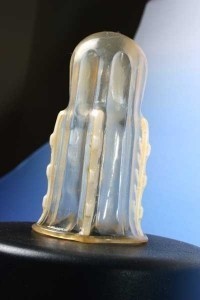A year after South African doctor Sonnet Ehlers introduced the Rape-aXe in various South African cities hosting the 2010 World Cup games, some interesting questions arise about the "Venus Flytrap" condom, and how it might serve cosmopolitan women in the U.S. and Europe.
For those who don't know about this anti-vaginal penetration device, the Rape-aXe female latex condom is inserted like a tampon. It's lined with rows of serrated teeth-like hooks that attach to a penis during penetration. Once it "lodges, only a doctor can remove it" -- a procedure Dr. Ehlers intends to be done with authorities on standby to make an arrest. "It hurts; [the presumed rapist] cannot pee and walk when it's on," Dr. Ehlers said. "If he tries to remove it, it will clasp even tighter... however, it doesn't break the skin, and there's no danger of fluid exposure."

As a New York woman on the go, the idea of putting something like that inside my lady parts gives me the creeps. (Anyone else with me?) And how exactly would I use it? It's certainly not, as detractors of the Rape-aXe have suggested, a modern day chastity belt, expected to be worn at all times. Still, when exactly would I put it in? When leaving campus after teaching a late class? On a night out with the girls? When taking certain subway lines to the "other side of the tracks?" When wearing my provocative come-freak-me boots?
And where would I store the device? Most women I know have some sort of go-to "make-up" bag, a LeSportSac or Commes des Garcons clutch -- its contents ranging from Sweet Spot toilettes, mints, tampons, warming ribbed rubbers, perfume roller ball and mini tubes of lube. Would the Rape-aXe go in there, or in the compartment of my Hobo bag devoted to mace and pepper spray? (You need a back-up. If your attacker manages to wrangle the mace from you, at least you have the pepper spray; albeit it's hard to procure pepper spray from your Hobo bag after a mace attack.)
It's not that cosmopolitan women are immune from rape: quite the contrary. I've spoken to many rape survivors who are accomplished professionally and personally and at either end of the socioeconomic scale. The question becomes, what does the distribution of the Rape-aXe condom add to the discussion about rape, and is it salient to cosmopolitan women who seem to have a device for everything?
Jezebel columnist Katy Kelleher pointed out that Dr. Ehlers introduced the Rape-aXe in an area of the world where rape is an epidemic:
It was introduced in South Africa to address the terrifying frequency of sexual assault. South Africa has one of the highest levels of rape in the world; a 2006 study found that a woman is raped every 17 seconds. To make matters even worse, a 2009 Amnesty International report found that out of over 20,000 reports of rape, only 8% led to convictions.
Getting into a discussion about reproductive rights and women's health in Africa is another story -- one worth sinking your teeth into (my sister-in-law is headed to Ethiopia as part of one of Melinda Gates' initiatives, and I look forward to hearing, and writing, about her upcoming work) but we'll have to wait a couple months. In the meantime, it's worthwhile to consider that although we might not be able to call rape an epidemic in the United States, women in this country are economically, judicially, and psycho-socially raped on epidemic proportions. True story.
So as fascinating as musing the Rape-aXe condom may be...
A Manhattan public health advocate who specializes in family planning expressed concern for the safety of women using such a device as protection:
The attacker may become even more enraged due to the emasculating pain, and escalate his level of violence upon the victim. And what about anal or oral rape? This device doesn't safeguard against those types of attacks on women.
A noted feminist Freudian psychologist in the West Village cackled with the notion of the "Venus Flytrap" condom:
You mean the penis flytrap condom! There's something primal and Biblical about this device. I think the idea of attaching teeth to an attacker's genitals is a very healthy response from a victim who herself has suffered the violence of sexual assault.
Biblical, okay. But we're cosmopolitan women? Is this something we'd consider adding to our arsenal of Thierry Mugler Womanity travel lotion, Pamela Love dagger necklace (fashionable and practical) and old Erica Jong paperbacks (subway reading)?
Here's an idea: we can spend money/energy on studying male aggression towards women (sexual and otherwise -- as rape is not necessarily an exclusively sexual act). Not only can we investigate core roots of misogyny, and I think it might be beneficial to all parties to do so with empathic dialog, we can spend resources educating men that raping women is, to quote Whitney Houston, whack. Or we can fund lobbying for more stringent rape laws and fewer Congressional debates about what constitutes rape (seriously, people, if the issue of consent isn't understood by 2011, we're in trouble).
It's not that I'm totally against the idea of the Rape-aXe. Anything that can make a woman feel like a superhero (and is more empowering than a pair of bracelets) has rad potential. The idea is to think about what message devices like these send women, and to acknowledge the danger of what it means to literally internalize fear.
